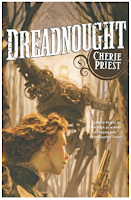Cherie Priest, Dreadnought
So ten years ago (!), I read and reviewed Cherie Priest's Boneshaker for this blog, and immediately got into an argument with my much more SF-aware friend Fraser. Not one for pulling his punches, among other things, he said this: "Quit reading half-decent, half-baked SF, and then praising it conscientiously."
Maybe he didn't notice that Boneshaker had been nominated for both the Hugo and the Nebula in 2009, plus won the 2010 Locus award, but more likely he wouldn't view those as markers of quality (which is fine by me, to be honest, because I feel the same way about the literary fiction that's more within my bailiwick, but still). Other Locus winners within ten years of Priest's win, though, include Kim Stanley Robinson, Liu Cixin, Neal Stephenson, and China Mieville, so they've got a decent record.Dreadnought is part of the same Clockwork Century series inaugurated by Boneshaker, but it's much more tangentially my thing than the earlier novel, which was almost exactly up my alley. Essentially, Dreadnought is an extended chase scene, albeit through multiple interesting chases and with the chasers switching up at different points, with the novel's ultimate intended destination being the 19th-century post-apocalyptic Seattle that's at the centre of Boneshaker. Me, I'd much rather just spend more time in her Seattle, but I really enjoyed Dreadnought regardless.
In brief: the US Civil War has been continuing for more than 20 years so far, at the time of the novel's present, and this has changed everything about the United States. Among other things, the Union and the Confederacy have developed what amount to battlemechs, giant humanoid robot-type creations that have two men inside to drive them: the Union's is powered by steam, but the Confederacy's is more powerful because it's partly run by diesel, thus keeping the internal temperature down. (This conflict between steam and oil, incidentally, so different from that of our own past, lies quietly behind much of the Clockwork Century.) Trains have gone fully slaughterhouse steampunk, too, and the politics of Texas and the continental West are of course wildly different since the USA has been too preoccupied by civil war to bother with the expansionism that marks our own 19th-century timeline.
And so we travel with the recently widowed Vinita Lynch, known to all as "Mercy," from her nursing position at the Richmond Hospital in Virginia, towards Seattle and her father who abandoned Mercy and her mother when she was a young girl. Along the way we encounter dirigibles, trains, raiders, variously horrific injuries that need Mercy's treatment, deaths almost beyond counting, and the mysterious consequences of addiction to a drug called "sap."
Really, though, the great mystery of the novel is a vanished regiment of Mexican soldiers, sent north to Texas, about whom stories begin to circulate that they're eating everything they encounter on their random path: plants, animals, and people. Eventually, Mercy's story intersects with theirs, in a way that makes perfect sense if you've read Boneshaker, and that to me makes zombie-ishness genuinely intriguing.
Mercy's a great character, and so are many of her fellow travellers. The suspense and drama is all well managed, and it's kind of an American steampunk Italian Job chase scene for most of its 300 pages, if you see what I mean. (Not actually The Italian Job, mind you, but what people say about the movie!)
Great fun for me, though not much beyond that, but it's likely that others' mileage will vary. After all, Dreadnought did win the Endeavor Award in 2011 (best SF novel by a Pacific Northwest author) and was nominated for the Goodreads Choice Award for SF. I'll be reading the other three novels in this series this summer, if I'm able to take any control of my own reading list!

Comments